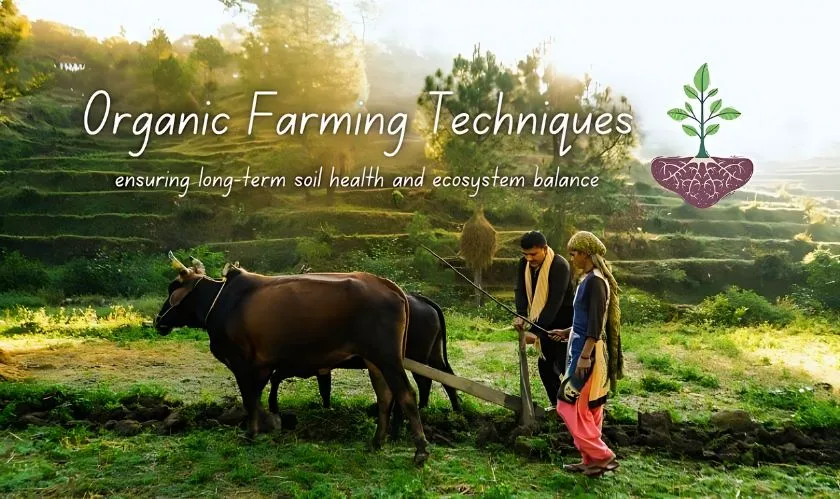Home Industry Agro tech The Top 10 Organic Farming Tec...
Agro Tech

CIO Bulletin
07 June, 2024
Organic farming is more than just a trend—it's a sustainable agriculture practice that prioritizes soil fertility, crop diversity, and ecological balance. For many farmers, this approach is a deeply rooted philosophy, emphasizing a harmonious relationship with nature. By leveraging natural processes and avoiding synthetic chemicals, organic farmers can produce healthy, nutrient-rich crops while preserving the environment for future generations.
Organic farming is about nurturing the soil, recognizing it as a living ecosystem rather than just a medium for plants. Techniques like composting and green manuring enrich the soil with organic matter, fostering a vibrant microbial community that helps plants thrive. Farmers who practice crop rotation and polyculture mimic natural ecosystems, enhancing biodiversity and resilience against pests and diseases.
This approach also involves a keen understanding of natural pest management. Instead of relying on chemical pesticides, organic farmers utilize biological pest control methods, such as introducing beneficial insects that prey on crop-damaging pests. This not only reduces the need for harmful chemicals but also creates a balanced and sustainable agricultural environment.
Water conservation techniques are another cornerstone of organic farming. Methods like drip irrigation and rainwater harvesting ensure that every drop of water is used efficiently, which is crucial in regions facing water scarcity. These practices help maintain the delicate balance of ecosystems while ensuring crops receive adequate hydration.
Organic farming is a holistic approach that integrates the well-being of the environment, crops, and farmers. It’s about more than just avoiding chemicals; it’s about creating a sustainable and thriving agricultural system. By adopting these practices, farmers are not only able to maximize their yields and boost soil health but also contribute to a healthier planet. Through this commitment to sustainability, organic farming stands as a beacon of hope for the future of agriculture, demonstrating that it is possible to feed the world while caring for the Earth.
Crop Rotation
Overview:
Crop rotation involves growing different types of crops in the same area across a sequence of seasons. This technique helps prevent soil depletion and reduces the build-up of pathogens and pests that occur when one species is continuously cropped.
Benefits:
Crop rotation enhances soil fertility by alternating deep-rooted and shallow-rooted plants, allowing different nutrients to be utilized and replenished. This method also breaks pest and disease cycles, reducing the need for chemical pesticides. Additionally, it helps manage weed pressure by disrupting their growth patterns.
Green Manuring
Overview:
Green manuring is the practice of growing certain crops specifically to be plowed under and incorporated into the soil while they are still green. These crops, often legumes, enrich the soil with organic matter and nutrients.
Benefits:
Green manuring improves soil structure, increases nutrient availability, and promotes beneficial microbial activity. It is particularly effective in adding nitrogen to the soil, thanks to the nitrogen-fixing capabilities of leguminous plants. This practice also helps suppress weeds and reduce soil erosion.
Composting
Overview:
Composting is the process of decomposing organic matter, such as crop residues and animal manure, into nutrient-rich humus. This humus can be added to the soil to enhance its fertility and structure.
Benefits:
The benefits of composting are numerous. It recycles nutrients back into the soil, improves soil structure, enhances water retention, and fosters beneficial microbial activity. Composting also reduces the need for chemical fertilizers and helps in waste management by recycling farm and kitchen waste.
Biological Pest Control
Overview:
Biological pest control involves using natural predators, parasites, or pathogens to manage pest populations. This method is a cornerstone of organic farming, as it minimizes the need for synthetic pesticides.
Benefits:
Biological pest control maintains ecological balance by encouraging biodiversity. It reduces the reliance on chemical interventions, which can harm non-target species and the environment. Additionally, it often leads to more sustainable and long-term pest management solutions.
Integrated Weed Management
Overview:
Integrated weed management (IWM) combines various agronomic practices to control weed populations. These practices include crop rotation, mulching, mechanical weeding, and the use of cover crops.
Benefits:
IWM reduces the reliance on chemical herbicides, promoting a healthier farm ecosystem. By combining multiple strategies, it provides more effective and sustainable weed control. This approach also helps maintain soil health and fertility, as it avoids the detrimental effects of continuous herbicide use.
Polyculture and Intercropping
Overview:
Polyculture involves growing multiple crop species in the same space, while intercropping is the practice of growing two or more crops in proximity. Both techniques mimic natural ecosystems and can lead to increased biodiversity and productivity.
Benefits:
Polyculture and intercropping can improve soil health by promoting a diversity of root structures and nutrient usage. They can also enhance pest and disease resistance, as a variety of plants can create less favorable conditions for pests. Moreover, these practices often lead to higher overall yields and reduced risk of total crop failure.
Organic Mulching
Overview:
Organic mulching involves covering the soil with organic materials such as straw, leaves, or grass clippings. This layer helps protect the soil and support plant growth.
Benefits:
Organic mulching conserves soil moisture, regulates soil temperature, and reduces weed growth. It also adds organic matter to the soil as the mulch decomposes, enhancing soil fertility and structure. Additionally, mulching can protect plant roots from extreme temperatures and help prevent soil erosion.
Agroforestry
Overview:
Agroforestry integrates trees and shrubs into agricultural landscapes. This practice can include alley cropping, silvopasture, and riparian buffer strips, combining the benefits of forestry and agriculture.
Benefits:
Agroforestry improves biodiversity, enhances soil health, and provides additional income sources through timber, fruit, or nut production. It can also improve water management by reducing runoff and erosion. Trees in agroforestry systems can act as windbreaks, protect crops, and provide habitats for beneficial wildlife.
Water Conservation Techniques
Overview:
Water conservation techniques in organic farming include methods such as drip irrigation, rainwater harvesting, and the use of drought-resistant crop varieties. These practices aim to maximize water efficiency and reduce wastage.
Benefits:
Efficient water use is crucial for sustainable agriculture, especially in regions facing water scarcity. Techniques like drip irrigation deliver water directly to the plant roots, minimizing evaporation and runoff. Rainwater harvesting captures and stores rainwater for future use, reducing dependence on groundwater and surface water sources. These practices ensure that crops receive adequate water while conserving this vital resource.
Soil Testing and Amendments
Overview:
Regular soil testing helps farmers understand the nutrient status and pH level of their soil. Based on these tests, organic amendments such as compost, manure, and lime can be added to correct deficiencies and improve soil health.
Benefits:
Soil testing allows for precise nutrient management, ensuring that plants receive the necessary nutrients without over-application. This precision reduces the risk of nutrient runoff, which can harm the environment. Organic amendments improve soil structure, increase microbial activity, and enhance the soil's ability to retain water and nutrients.
Conclusion
Embracing organic farming techniques not only enhances crop yield but also promotes sustainable agriculture, ensuring long-term soil health and ecosystem balance. Practices like crop rotation, green manuring, composting, and biological pest control create a resilient farming system that reduces reliance on synthetic inputs and fosters biodiversity.
Integrated weed management, polyculture, and agroforestry contribute to a robust agricultural landscape that can withstand environmental challenges. Water conservation techniques and regular soil testing ensure that resources are used efficiently and sustainably.
By implementing these top 10 organic farming techniques, farmers can achieve high yields while protecting the environment, thus paving the way for a sustainable and productive future in agriculture.
FAQs
1. How does crop rotation contribute to increased soil fertility and pest management in organic farming?
Crop rotation prevents soil depletion by alternating crops with different nutrient requirements. It breaks pest and disease cycles, reducing the need for chemical interventions and promoting a healthier farm ecosystem.
2. What are the key benefits of using green manuring as an organic farming technique?
Green manuring enhances soil fertility, improves soil structure, and adds organic matter. It also fixes nitrogen in the soil, suppresses weeds, and reduces erosion, contributing to overall soil health.
3. How can biological pest control methods reduce the need for chemical pesticides in organic farming?
Biological pest control uses natural predators and parasites to manage pests, reducing reliance on chemical pesticides. This method maintains ecological balance and prevents harm to non-target species and the environment.
4. What are the advantages of implementing integrated weed management in organic farming practices?
Integrated weed management combines multiple strategies to control weeds effectively. It reduces the need for chemical herbicides, protects soil health, and promotes a more sustainable and resilient farming system.
5. How do water conservation techniques like drip irrigation and rainwater harvesting enhance sustainability in organic farming?
Water conservation techniques maximize water efficiency and reduce wastage. Drip irrigation delivers water directly to plant roots, minimizing evaporation. Rainwater harvesting captures and stores rainwater, reducing dependence on other water sources and ensuring sustainable water use.







